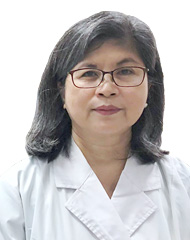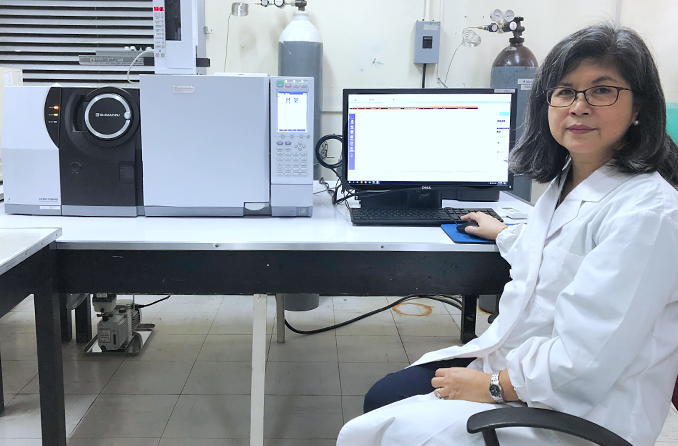Celebrating 50 Years of MS Innovation - User interviews March 2020
On the occasion of Shimadzu's 50th year of producing mass spectrometry instruments, we talk to researchers using Shimadzu MS instruments in their daily work and ask about their expectations for Shimadzu and the future of MS technology.

Dr. Charita S. Kwan
Head of the Research and Analytical Services Laboratory, Natural Sciences Research Institute, University of the Philippines Diliman
Main field of study:
Analytical and environmental chemistry focusing on micropollutants both organic and inorganic such as Persistent Organic Pollutants (POPs), Endocrine Disrupting Compounds (EDCs), and trace metal speciation, and their measurement and fate in the environment.
1. How did you become familiar with Shimadzu?
When I started working as a research assistant in the mid 1980’s, my first exposure to a Shimadzu equipment was the old Shimadzu AA-600 equipped with a Shimadzu U-125 recorder in our laboratory. I used the equipment in the measurement of trace metals in water, sediments and rice samples.
2. What is your main field of research, and how are you utilizing Shimadzu equipment?
In the first 15 years of my scientific career, I gained expertise in the measurement of inorganic micropollutants, specifically trace metals, including speciation. I initially used the Shimadzu AA-600 AAS for establishing the performance characteristics of analytical methods for trace metals as well as measuring their concentrations in different environmental samples. Today, the laboratory continues to carry out our own research as well as serving the needs of researchers on trace metals using the AA-6800 AAS in the lab.
Over the past 20 years, I have become involved in the measurement of organic micropollutants, especially POPs and EDCs. In 2000, our laboratory was chosen to represent the Philippines in the Shimadzu-sponsored United Nations University project on “Environmental Monitoring and Governance in the East Asian Coastal Hydrosphere”. The project involved the measurement of EDCs and POPs such as organochlorine pesticides (OCPs), phenols, phthalates, PCBs, PBDEs in water, sediments and biota. At first, the concentration levels of OCPs and phenols were measured using the GCMS-QP5000, but it was later upgraded to a GCMS-QP2010. Thanks to the availability of the equipment, we were able to further develop the analytical capabilities of the laboratory, e.g. for the measurement of polycyclic aromatic hydrocarbons in both environmental (water, sediments, biota, air filters) and food samples. The use of the equipment (especially the GCMS-QP2010) was also extended to the thesis and dissertation research of graduate students as well as the training requirements of other government laboratories for their laboratory staff, contributing to the development of new talent and greater manpower in our country.
In 2019, we were able to acquire the GCMS-TQ8040 for a project on developing information infrastructure for managing EDCs in a selected body of water in the Philippines. The equipment is used for the measurement of organochlorine and organophosphate pesticides, phenols and hormones in water, sediments and in particulate matter. It is also used in the thesis and dissertation research of graduate students, as well as in servicing the analytical requirements of other researchers and private institutions.
3. What are your reasons for choosing Shimadzu equipment?
Choosing Shimadzu equipment over other brands has become a tradition of our laboratory dating back to the time of my predecessors. For us, the most important benefit of Shimadzu equipment is the after-sales support provided by the local representative, Shimadzu Philippines Corporation. With their support, we are able to extend the life of our Shimadzu equipment to more than 10 years (e.g. the Shimadzu AA-600 for about 20 years, and the Shimadzu GCMS-QP2010 for 17 years).
4. What trends are you seeing in your field with regards to the use of mass spectrometry?
As an analytical and environmental chemist, I hope to see the accurate and precise measurements of environmental micropollutants and food contaminants at very low concentration levels. More importantly, a mass spectrometer that is reliable, robust, easy to use and maintain so that we can reduce downtime and costs for repairs.
5. What are your expectations for Shimadzu and for MS technology in general in the future?
Where technology is concerned, I think Shimadzu is always doing its best to develop and offer products that can compete in the market. As an end user of these equipment, I expect at least the same commitment, if not improved, to support their customers after the equipment has been sold and installed. This means that service engineers are well-trained and are capable of handling this highly specialized equipment. This is especially critical for laboratories in developing countries that may not have readily available funds for buying new equipment or even for repairs.



